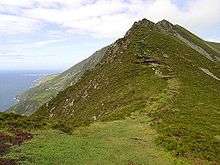Áed mac Bricc
| Áed mac Bricc | |
|---|---|
 Slieve League (Sliabh Liacc) in Donegal where Áed is said to have been a hermit for some time | |
| Died | 589 |
| Feast | 10 November |
| Patronage | headache sufferers |
Áed mac Bricc (died 589) was an Irish bishop and saint.
Life
Áed's principal church was at Rahugh (Ráith Áeda Meic Bricc) in modern County Westmeath. He was regarded as a patron saint of the Uí Néill and was said to be a descendant of Fiachu mac Néill. When his brothers refused to allow him a share of the land his father had maintained, Áed carried off a girl who belonged to them. He hoped to force his brothers to give him his patrimony through this injury, but then he met the bishop St Illann, who convinced him to give up his claims to the land and to let the girl go.[1]
Áed mac Bricc's life in the Codex Salmanticensis presents Áed as a peacemaker between Munster and the Uí Néill, and between Mide and Tethbae, befitting his cross-border descent through his mother, Eithne, from the neighbouring Munster people of Múscraige Tíre (north-west co. Tipperary).[2]
An early Latin Life of Áed, perhaps dating from the period 750–850, survives.[3][4] Although the Life borrows from Adomnán's life of Columba, a copy of which may have been obtained from the nearby monastery of Durrow, its central concerns are with local violence and with the poverty and insecurity of women, especially nuns.[2] Áed seems to have had a profound interest in the well-being of religious women. He frequently visited settlements of holy virgins who received him with the respect due to a man of his position. On one occasion, when he perceived that the girl serving him was pregnant he fled from the building both to avoid the pollution and to shame her. She confessed her sins and did penance. Áed was not one to leave someone under his care in a difficult situation; he blessed her womb and the baby disappeared as if it had never been there.[1]
Patronage
Medieval incantations against headache enumerate bodily organs to be protected. One 8th-century Latin hymn from Lake Constance using this device is addressed to St. Aid "mechprech", who has been identified as Aed Mac Bricc, Bishop of Killare, 6th century.[5] An episode in the Life in which he heals Brigit of headache is echoed in the ninth-century Irish life of Brigit. A stone close to the existing church is still associated with the curing of headaches.[2]
References
- 1 2 "Life of "Áed mac Bricc", Monastic Matrix
- 1 2 3 Stalmans, Nathalie, and Charles-Edwards, T. M., Meath, saints of (act. c.400–c.900), Oxford Dictionary of National Biography, Oxford University Press, 2004; online edn, May 2007
- ↑ This dating owes much to the work of Richard Sharpe, Medieval Irish Saints' Lives, chapter 10; cf. 300, 328-329. He argues an earlier date for Aed's vita based on archaic spellings in the Codex Salmanticensis, names which in later recensions have been updated. To this evidence Jim Tschen Emmons added that the vita in CS conforms more closely to earlier saints' Lives, particularly that of St. Martin of Tours with which it shares certain similarities and that of St. Brigit in its episodic nature (Emmons, "Limits of Late Antiquity," Ch. 2). Moreover, one sees no evidence of the reforms of the Celi De nor the Gregorian reforms--these absences do not preclude a later date, but taken with the other evidence helps support an earlier date (Emmons, "Limits of Late Antiquity," 139).
- ↑ Emmons also provides a translation and commentary for the version of the vita in CS. See Appendix A in his "Limits of Late Antiquity."
- ↑ Isler H, Hasenfratz H, and O'Neill T., "A sixth-century Irish headache cure and its use in a south German monastery", Cephalalgia, 1996 Dec;16(8):536-40
Sources and further reading
- Charles-Edwards, T. M. (2000), Early Christian Ireland, Cambridge: Cambridge University Press, ISBN 0-521-36395-0
- Emmons, James B. Tschen. "The Limits of Late Antiquity: The Life of St. Aed mac Bricc and the Irish Literati in Late Antiquity." Diss. UC Santa Barbara, 2002.
- Emmons, Jim Tschen. "Spiritual Landscapes: The Late Antique Desert in Ireland." In The Rhetoric of Power in Late Antiquity: Religion and Politics in Byzantium, Europe and the Early Islamic World. Robert M. Frakes, Elizabeth dePalma Digeser, and Justin Stephens, eds. London: I.B. Tauris, 2010. pp. 125–143.
- Nagy, Joseph Falaky (1997), Conversing with angels and ancients: literary myths of medieval Ireland, Ithaca: Cornell University Press, ISBN 978-0-8014-8368-4
- Nathalie Stalmans and T. M. Charles-Edwards, "Meath, saints of (act. c.400–c.900)", Oxford Dictionary of National Biography, Oxford University Press, 2004; online edn, May 2007 accessed 3 Sept 2010
- Sharpe, Richard. Medieval Irish Saints' Lives: An Introduction to Vitae Sanctorum Hiberniae. Oxford: Clarendon, 1991.